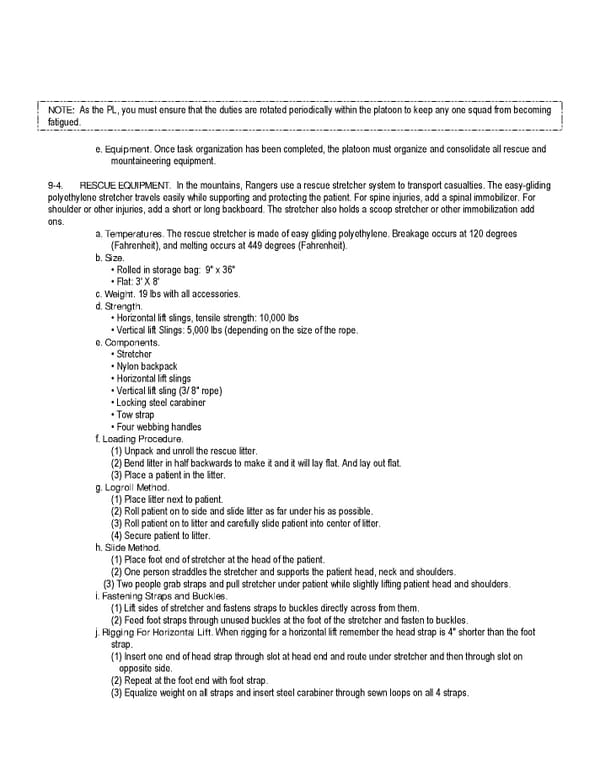NOTE: As the PL, you must ensure that the duties are rotated periodically within the platoon to keep any one squad from becoming fatigued. e. Equipment. Once task organization has been completed, the platoon must organize and consolidate all rescue and mountaineering equipment. 9-4. RESCUE EQUIPMENT. In the mountains, Rangers use a rescue stretcher system to transport casualties. The easy-gliding polyethylene stretcher travels easily while supporting and protecting the patient. For spine injuries, add a spinal immobilizer. For shoulder or other injuries, add a short or long backboard. The stretcher also holds a scoop stretcher or other immobilization add ons. a. Temperatures. The rescue stretcher is made of easy gliding polyethylene. Breakage occurs at 120 degrees (Fahrenheit), and melting occurs at 449 degrees (Fahrenheit). b. Size. • Rolled in storage bag: 9" x 36" • Flat: 3' X 8' c. Weight. 19 lbs with all accessories. d. Strength. • Horizontal lift slings, tensile strength: 10,000 lbs • Vertical lift Slings: 5,000 lbs (depending on the size of the rope. e. Components. • Stretcher • Nylon backpack • Horizontal lift slings • Vertical lift sling (3/ 8" rope) • Locking steel carabiner • Tow strap • Four webbing handles f. Loading Procedure. (1) Unpack and unroll the rescue litter. (2) Bend litter in half backwards to make it and it will lay flat. And lay out flat. (3) Place a patient in the litter. g. Logroll Method. (1) Place litter next to patient. (2) Roll patient on to side and slide litter as far under his as possible. (3) Roll patient on to litter and carefully slide patient into center of litter. (4) Secure patient to litter. h. Slide Method. (1) Place foot end of stretcher at the head of the patient. (2) One person straddles the stretcher and supports the patient head, neck and shoulders. (3) Two people grab straps and pull stretcher under patient while slightly lifting patient head and shoulders. i. Fastening Straps and Buckles. (1) Lift sides of stretcher and fastens straps to buckles directly across from them. (2) Feed foot straps through unused buckles at the foot of the stretcher and fasten to buckles. j. Rigging For Horizontal Lift. When rigging for a horizontal lift remember the head strap is 4" shorter than the foot strap. (1) Insert one end of head strap through slot at head end and route under stretcher and then through slot on opposite side. (2) Repeat at the foot end with foot strap. (3) Equalize weight on all straps and insert steel carabiner through sewn loops on all 4 straps.
 Ranger Handbook Page 169 Page 171
Ranger Handbook Page 169 Page 171